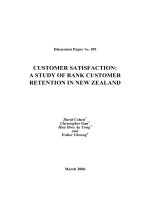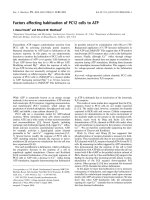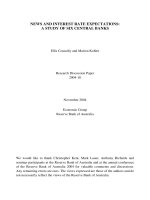Factors affecting word of mouth a study of facebook fan pages
Bạn đang xem bản rút gọn của tài liệu. Xem và tải ngay bản đầy đủ của tài liệu tại đây (2.42 MB, 84 trang )
UNIVERSITY OF ECONOMICS HO CHI MINH CITY
International School of Business
------------------------------
Tran Ngoc Tu
FACTORS AFFECTING WORD-OF-MOUTH:
A STUDY OF FACEBOOK FAN PAGES
MASTER OF BUSINESS (Honours)
Ho Chi Minh City – Year 2014
UNIVERSITY OF ECONOMICS HO CHI MINH CITY
International School of Business
------------------------------
Tran Ngoc Tu
FACTORS AFFECTING WORD-OF-MOUTH:
A STUDY OF FACEBOOK FAN PAGES
ID: 21110026
MASTER OF BUSINESS (Honours)
SUPERVISOR: Dr. Nguyen Thi Mai Trang
Ho Chi Minh City – Year 2014
ACKNOWLEDGEMENT
This thesis could not be accomplished without the help, advise, support,
guidance and encouragement of many people.
I would like to express my sincere gratitude to my supervisor, Dr. Nguyen Thi
Mai Trang, for her guidance and correction to my thesis, especially for her enthusiasm
in quickly answering and support.
Second, I would like to express my deepest gratitude to Professor Nguyen Dong
Phong, Professor Nguyen Dinh Tho, and Dr. Tran Ha Minh Quan for their valuable
time as the members of the proposal examination committee. My sincere thanks are
also to all the members of ISB create the best convenience for me as well as ISB
students during the course. Thirdly, I would like to thank my dear colleagues, friend
and classmates for their invaluable advice, encouragement and help me collect the
research data. Last but not least, I would like to express my great thanks to my family
for their encouragement and assistance for my three years study the master course and
finish this thesis.
i
ABSTRACT
Vietnam has been one of the fastest growing countries in Internet and social
networking sites for years. Facebook is the most popular social media site, nearly 25
million of the 36 million Internet users in Vietnam (VietnamNet, 2014).
Understanding the influences of Facebook to the youngster’s behavior, many business
organizations build fanpages on the social media site to build better connection with
their customers.
Identifying the factors affecting brand wordofmouth through the study of
Facebook fanpages can help the organization understanding the motivation of
Facebook users who involving in their brand fanpage. As a result, those factors,
which have huge impact on the wordofmouth, are Content value (including
Functional value and Hedonic value), and Interaction value of the Facebook brand fan
page. Therefore this research can help improving business if people know which ones
to investment.
Keywords: word-of-mouth, brand fan-page, Facebook, Vietnam.
ii
LIST OF ABBREVIATIONS
EFA
Exploratory Factor Analysis
KMO
KaiserMeyerOlkin
WOM
WordOfMouth
SPSS
Statistical Package for the Social Science software
SMM
Social media marketing
SNS
Social networking sites
B2C
Businesstocustomer
iii
LIST OF TABLES
Table 1.1: Top 10 Social Media Sites Among Internet Users in Vietnam, April 2013. . 1
Table 4.1: Sample characteristics. .............................................................................. 30
Table 4.2: Functional Variables ItemTotal Statistics ................................................. 31
Table 4.3: Reliability test results ................................................................................ 33
Table 4.4: Rotated Component Matrix ....................................................................... 34
Table 4.5: Final Rotated Component Matrix .............................................................. 36
Table 4.6: Casewise Diagnostics ............................................................................... 38
Table 4.7: Multiple Regression ANOVA ................................................................... 39
Table 4.8: Mutiple Regression Coefficients .............................................................. 40
Table 4.9: Simple Regression ANOVA ..................................................................... 41
Table 4.10: Simple Regression Coefficients............................................................... 42
iv
LIST OF FIGURES
Figure 2.2: Conceptual Model.................................................................................... 18
Figure 3.1: Research process ..................................................................................... 24
Figure 4.1: Hofstede interculture dimemsions comparision ........................................ 45
v
CONTENTS
ACKNOWLEDGEMENT ................................................................................. i
ABSTRACT ..................................................................................................... ii
LIST OF ABBREVIATIONS ..........................................................................iii
LIST OF TABLES ........................................................................................... iv
LIST OF FIGURES .......................................................................................... v
CHAPTER 1: INTRODUCTION ..................................................................... 1
1.1. Research Background ............................................................................. 1
1.2. Research Problem ................................................................................... 3
1.3. Research Objectives ............................................................................... 5
1.4. Research Methodology ........................................................................... 5
1.5. Research Scope....................................................................................... 5
1.6. Structure of the Research ........................................................................ 6
CHAPTER 2: LITERATURE REVIEW ........................................................... 8
2.1. Social networking sites ........................................................................... 8
2.2. Brand Communities ................................................................................ 9
2.3. Facebook .............................................................................................. 10
2.4. Brand Fanpages ................................................................................... 11
2.5. Motivation of Facebook Brand Fan Pages............................................. 12
2.6.1. Fanpage functional value .............................................................. 13
2.6.2. Fanpage hedonic value .................................................................. 14
2.6.3. Social interaction value .................................................................. 14
2.6.4. Selfconcept value .......................................................................... 15
2.7. Word of Mouth ..................................................................................... 16
2.8. Proposal model and hypotheses ............................................................ 18
CHAPTER 3: RESEARCH METHODOLOGY.............................................. 20
3.1. Research method .................................................................................. 20
3.2. Research design .................................................................................... 20
3.2.1. Informants of the study .................................................................. 20
vi
3.2.2. Sample size and Sampling method ................................................. 21
3.2.3. Measurement scale ......................................................................... 21
3.3 Research process ................................................................................... 24
3.3.1 Qualitative research....................................................................... 24
3.3.2 Quantitative research ..................................................................... 26
3.3.3 Data analyzing .............................................................................. 27
3.4. Data analysis method ............................................................................ 28
CHAPTER 4: DATA ANALYSIS AND RESULTS ....................................... 29
4.1. General characteristic of the research sample........................................ 29
4.2. Reliability test: The Cronbach’s alpha test ............................................ 30
4.2.1. Fanpage functional value .............................................................. 31
4.2.2. Fanpage hedonic value .................................................................. 31
4.2.3. Social interaction value .................................................................. 32
4.2.4. Selfconcept value .......................................................................... 32
4.2.5. Fanpage usage intensity ................................................................ 32
4.2.6. WordofMouth .............................................................................. 32
4.3. Exploratory factor analysis ................................................................... 34
4.4. Multiple regression analysis.................................................................. 37
4.4.1. Assumption 1: The linear relationship ............................................ 37
4.4.2. Assumption 2: Homoscedasticity of residuals ................................ 38
4.4.3. Assumption 3: No multicollinearity................................................ 38
4.4.4. Assumption 4: No significant outliers ............................................ 38
4.4.5. Assumption 5: Residuals are normally distributed .......................... 38
4.4.7. Result of multiple regression analysis ............................................ 39
4.5. Simple regression analysis .................................................................... 40
4.5.1. Assumption 1: Homoscedasticity of residuals ................................ 41
4.5.2. Assumption 2: Residuals are normally distributed .......................... 41
4.5.5. Result of simple regression analysis ............................................... 41
4.6. Hypotheses assessment and discussion ................................................. 42
CHAPTER 5: DISCUSSION AND CONCLUSION ....................................... 46
5.1. Conclusion............................................................................................ 46
vii
5.2. Managerial implications ....................................................................... 48
5.2.1. Social interaction value .................................................................. 49
5.2.2. Fanpage functional value .............................................................. 50
5.2.3. Fanpage hedonic value .................................................................. 50
5.3. Limitations ........................................................................................... 51
REFERENCES ............................................................................................... 52
APPENDIX A: QUESTIONARIES ................................................................ 59
APPENDIX B: SURVEY RESULTS ............................................................. 67
APPENDIX C: MULTIPLE LINEAR REGRESSION.................................... 70
APPENDIX D: SIMPLE LINEAR REGRESSION ......................................... 73
viii
CHAPTER 1: INTRODUCTION
1.1. Research Background
The world is living in the information age and the social networks have
unpredictable growth last few years. According to Internet World Stats (2013), there
were about 2.8 billion Internet users as of 31 December 2013 worldwide, which
increased nearly 676.3%, compare with 361 million Internet users worldwide in 2000.
Social networking sites such as Facebook, YouTube, or LinkedIn are playing more
important roles in business communications According to McKinsey (2012) there are
more than 1.5 billion users on using social networks, 70% companies advocated social
media technologies to transform businesses and improve organizational performance.
Table 1.1: Top 10 Social Media Sites Among Internet Users in Vietnam, April
2013.
Total
Total unique
minutes
visitors
(millions of
Total visits
(millions)
minutes)
(millions)
1. Facebook
11.8
4,768
345.3
2. Zing Me
5.3
262
50.7
3. Blogger
5.3
38
15.5
4. WordPress.Com
2.8
27
8.1
5. DienDanBacLieu.Net
2.0
2
3.0
6. KenhSinhVien.Net
1.5
1
2.3
7. LinkedIn
1.1
7
3.1
8. TamTay.Vn
0.7
6
1.6
9. KetNoi.Com
0.7
0
0.9
10. BlogTruyen.Com
0.6
19
3.7
Source: eMarketer (2013)
1
At the same time, Vietnam is one of Facebook fastestgrowing countries in the
world last few years. Vietnam hit 8.5 million users in October 2012, but in May 2014,
Facebook reached nearly 25 million users in the country (VietnamNet, 2014). Vietnam
is adding one million Facebook users per month. Given this rate of growth, Vietnam
will hit 30 million by October 2014 (Millward, 2014). Therefore, social networking
sites such as Facebook, which have a big impact on Vietnamese people’s lives.
Meanwhile in the global trends, the social networks are increasingly replacing
traditional media for marketing and communications. They have become a major
factor in influencing various aspects of consumer behavior including awareness,
information acquisition, opinions, attitudes, purchase behavior, and postpurchase
communication and evaluation (Mangold & Faulds, 2009, p. 538). As such, for
business, social networks offer the potential for (1) advertising by facilitating viral
marketing, (2) product development by involving consumers in the design process
and (3) market intelligence by observing and analyzing the user generated content
(Richter et al. 2011). The rapid growth of Facebook helps to open the potential of
transmitting companies’ marketing messages to their customers and entering into a
dialogue with them using the wordofmouth (WOM) principles.
Furthermore, business organizations continuously interact and analyze the
consumers’ activities on their brand fanpage after setup and maintain them on
Facebook. Social media marketing (SMM), a form of WOM marketing, is an outcome
of this trend (Kozinets et al., 2010). The SMM is not replacement for the traditional
techniques; it is used as additional traditional marketing channel that could be
integrated with the traditional ones as a part of the marketing mix. By monitoring and
2
analyzing conversations and feedback on Facebook brand fanpage, a company can
learn about customers’ needs (Palmer and KoenigLewis, 2009).
However, the adoption of Social Media for Marketing in Vietnam is still very
new. The remarkable development and prevalence of social networking sites just in a
very short time in Vietnam made a lot of organizations cannot overlook this
opportunity. As a consequence, being able to understanding the profound reasons of
the engagement of Facebook fanpage, businesspersons need to know what people
think and feel from different aspects of an issue. Beneath the participation is the
consciousness of benefits, analyzing human psychology toward the new trend can help
the managers aware the factors affect to their success. Applying suitable content
marketing or integrated marketing for promotion strategy on social networking sites
will bring the efficiency for their organization. To contribute in this direction, in this
research we find the factors that influence the level of WOM on Facebook brand fan
page.
1.2. Research Problem
The ways people exchange information with each other have been changing
dramatically over the last years (HennigThurau et al., 2010). The relationships
between consumers to each other and to organizations have also transformed by new
social media services. Compare to traditional relationships, companies pay active role
to reach customers through marketing activities and customers were passive
“receivers” of brand messages (Libai et al., 2010). Nowadays, both company and
customer involve actively in a “conversation” about the brand, customers can be
3
multipliers of brand messages, and creates opportunities for wordofmouth marketing
(Kozinetset et al., 2010)
SNSs offer customers many services to communicate with others, building up
new communication style that users and organizations easily to exchange ideas.
Facebook is the largest social networking sites, which offers companies many options
to keep contact with their customers or fans. Organizations nowadays utilize these
tools to engage their fans and interact with them. Fanpages are created to deliver
products’ information, much attractive content and get feedback from consumers
(Borle et al., 2012).
In Vietnam last few years, many people set up their own business through
Internet, particularly on Facebook and they doing marketing and selling things through
internet sites. As stated above, Vietnam has very impressive figures about the number
of people using social networking sites, so, what makes people get into social
networking sites that much and to increase the participation of people into Facebook
fanpages, what are necessary things?
Besides, the reason of joining in social networking sites stems from different
causes, for instance, individuals care for personal interests, while organizations think
about their business. Depending on particular purposes and objectives, each subject
will develop their account in an appropriate way. As we have seen, today, brand fan
pages are ideally for businesses in marketing communication. However, lack of
empirical research on fanpages and its role for the customerbrand relationship.
Especially there is lack of empirical study for the consumer motivation to use brand
fanpages.
4
1.3. Research Objectives
Regarding the related research results are already published of social
networking sites using motivation and brand communities engagement. This research
aims to identify the key factors of Facebook fanpages affecting consumers’ wordof
mouth and the drivers, which make a successful brand fanpages. Specifically, this
research will examine:
Impact of Fan-pages content (functional & hedonic) on fan-pages usage intensity.
Impact of Social Interaction on fan-page usage intensity.
Impact of Self-concept on fan-page usage intensity.
Impact of Fan-page usage intensity on Word-of-Mouth.
1.4. Research Methodology
The research method is the combination of qualitative and quantitative research.
It helps increase the accuracy and sufficiency of the study. Applying qualitative
research to collect the ideas and opinions allows the adjustment of the study is made.
While, the quantitative research guarantees many people take the survey and allows
the researcher to carry out the data analysis with more reliable results. Statistical
Package for the Social Science software (SPSS), an effective tool to analyze the data,
is used in data analysis chapter. The steps are to test the reliability of the scales
(Cronbach’s Alpha), Factor Analysis. Finally, the Regression is used to examine the
relationship between independents variables and dependent variables.
1.5. Research Scope
This study is to research the brand fanpages on Facebook, the most popular
Social Networking Sites (SNSs) in Vietnam. The survey will be conducted online and
5
limited in Vietnamese community. People who response the questionnaire mostly
come from the two biggest cities of Vietnam, Hanoi and Ho Chi Minh. Certainly, the
respondents of this study must know about Facebook, have created an account on it,
and join or like at least one brand fanpages; otherwise, their answers are not qualified
and cannot be used in the data analysis.
1.6. Structure of the Research
The research consists of five chapters:
Chapter 1: Introduction
This chapter presents research background of the study, as well as, research
problems, research objectives, research scopes.
Chapter 2: Literature Review and Hypotheses
This chapter provides the literature review and previous studies, and then the
research model of the study and the hypotheses are also discussed.
Chapter 3: Research Methodology
In this chapter, the method used to design and implement the research base on
the research objectives and scopes, the processes of doing the research are also
presented.
Chapter 4: Data Analysis and Data Results
All the data collected from the survey are analyzed. The final model of the
research is built based on the results of those analyses. Depending on output results
from the analyzing, each factor will be deeply discussed how it affects wordofmouth
in social networking sites.
Chapter 5: Conclusions and Limitations
6
Chapter 5 presents main conclusions and implications based on the results of
the previous chapters, some suggestions for the improvement as well as the limitations
of this study.
7
CHAPTER 2: LITERATURE REVIEW
2.1. Social networking sites
Mangold and Faulds (2009) described, social media is set of a wide range of
online, wordofmouth forums including blogs, companies’ sponsored discussion
boards, product or service ratings websites, Internet discussion boards and forums, and
social networking sites (SNS). Using web 2.0 technologies, social media creates highly
interactive platforms by individuals sharing information and creating communities.
People and organizations use social media to share, cocreate, and discuss user
generated content (Kietzmann et al., 2011).
A SNS is defined as “webbased services that allow individuals to (1) construct
a public or semipublic profile within a bounded system, (2) articulate a list of other
users with whom they share a connection, and (3) view and traverse their list of
connections and those made by others within the system.” (Boyd and Ellison, 2010).
Currently, social media sites vary in terms of their scope and functionality. Some
social media sites are for the general masses (i.e. Facebook, Google+) while others
(i.e. LinkedIn) are focused on professional networks. Media sharing sites (i.e.
YouTube, Picasa and Flickr) or blogging platforms (i.e. BlogSpot, WordPress) are also
members of the social media ecology (Kietzmann et al., 2011).
Social network sites and Facebook have been studied from different
perspectives such as the network structure (Caci et al., 2012), characteristics of the
users (Bhattacharyya et al., 2011), usage patterns (Golder et al., 2007), usage
motivations (Joinson, 2008), identity management and selfpresentation (Labrecque et
al., 2011), social interactions (Kostakos and Venkatanathan, 2010), and privacy and
8
information disclosure (Debatin et al., 2009). However, little has been published about
the use of Facebook and SNSs in the context of companies. Social media providing a
new channel for marketing that can access to a large number of consumers, grouped in
nongeographically bound communities, based on a structured set of social
relationships among admirers of a brand, i.e. brand communities (Schau et al., 2009).
In the businesstocustomer (B2C) interactions and usage motivations on Facebook are
in the focus of this research.
2.2. Brand Communities
Brand communities became very interested in branding research for more than
10 years. Muniz and O’Guinn (2001, p. 412) defined that “A brand community as
specialized, nongeographically bound community, based on a structured set of social
relationships among admires of a brand. It is specialized because at its center is a
branded good or service. Like other communities, it is marked by shared
consciousness, rituals and traditions, and a sense of moral responsibility.”
Furthermore, McAlexanderet al. (2002) showed four crucial relationships in a
brand community: between the customer and the brand, between the customer and the
firm, between the customer and the product in use, and among fellow customers.
Woisetschlager et al. (2008) found two reasons for consumer participation in brand
communities: community satisfaction and degree of consumer influence within the
community. Moreover, they showed an effect from community participation on word
ofmouth, brand image, and community loyalty. Kimet al. (2008) showed that online
community participants possess stronger brand commitment than consumers who are
not members of the community.
9
Brand communities were proved to be a tool for increasing sales (Adjei at al.,
2010). In addition, they have the potential of improving the relationship between the
consumers and the brand (Sicilia and Palazon, 2008) and may influence members’
perceptions and actions (Muniz and Schau, 2007). Brand communities facilitate
interactions through exchange of opinions about the brand or a particular product
among consumers, thus engaging their members in a form of WOM communication
(McAlexander et al., 2002).
Consequently, regarding the existing research on brand communities, we can
see community identification as a central influence for community participation.
Previous work has shown that brand community engagement can affect membership
loyalty, brand image, and wordofmouth (Bhattacharya et al., 1995). Thus,
community participation and membership can be seen as an important tool for a
successful branding strategy.
2.3. Facebook
Facebook is a consumeroriented network. The social media web site, LinkedIn,
is an example of a more businessoriented network (Palmer and KoenigLewis, 2009,
p. 165). Because Facebook is consumeroriented, this affects the way that users
perceive Facebook and the ethical standards that they demand from the service.
Furthermore, on Facebook, users create an account with a public or semipublic
profile. They then have the option of showing the identities of their friends, and
sharing photos and activity feeds (Palmer and KoenigLewis, 2009, p. 165). Users can
publish their own opinions, share with it others, and receive information about other
connected people. This leads to a form of collaboration, which creates new content
10
(Coulter & Roggeveen, 2012). Most of the communication is between users who also
know each other offline.
Most members see Facebook as a freeservice network; however, as Lilley et al.
(2012) points out, they are still affected by advertising from companies. For example,
banners and ads on Facebook encourage users to click on them, and spend money to
buy the companies’ products.
In addition, a study shows that Facebook is attractive to users because it builds
on: curiosity, we look at photos of friends and other people’s profiles; enjoyment, we
are able to communicate with others; and excitement, we can send gifts and play
games with others (Palmer and KoenigLewis, 2009).
Facebook provides five possibilities for companies to utilize the site for
marketing purposes: (1) Facebook Ads, (2) Facebook Brand Pages, (3) Social Plugins,
(4) Facebook Applications and (5) Sponsored Stories. Of these, Facebook pages
provide the largest number of engagement possibilities by direct interaction with the
consumers through dialog.
2.4. Brand Fan-pages
Brand fanpages are a special kind of brand community because they are
organized around a single brand, product, or company. However there are some
differences between brand fanpages on social networking sites and traditional online
brand communities: brand fanpages are embedded in an organic platform and not
brandrelated online network. Thus, “friends” of a fan who not participated in a fan
page also see what a fan interacted on brand fanpage and attracted by the content of
11
brand fanpage (Ellison, 2007). Therefore, fanpage membership can show a peer
group the own selfconcept.
In addition, brand fanpages are used as brand communication and interaction
channel by the driven of organizations. On one hand, the traditional online brand
community the brand is the center of the community and the community is “based on a
structured set of social relationships among admires of a brand” (Muniz and O’Guinn,
2001, p. 412). On the other hand, a brand fanpage on social networking sites is a
connection between the user and the brand. Therefore, there are some differences in
motivation between brand fanpage traditional brand communities.
Facebook offers companies several especially interesting tools for contacting
and communicating with their customers. Fanpages are useful services for companies.
Fans are emotional engagement and are selfidentification as fan (Kozinets et al.,
2010). Fan communities nowadays can build worldwide without the limitation of
geographical, thanks to the popular of Internet. In particular, users become fans of a
Facebook fanpage by pressing the “likebutton” which show on their “wallpage” that
they like this brand and these also be added to their profiles. Fans’ personal Facebook
news feed will display the new content of this fanpage automatically each time new
information posted to, and they can post comments on the fanpage, or share the
interesting from this page as well as interact with other fans.
2.5. Motivation of Facebook Brand Fan Pages
Existing research on social networking sites show that there are three main
motivation areas for consumers’ using social networking sites. The first is content
acquisition and sharing based on the personal interest, which can be functional value
12
as well as hedonic value. The second is a relationship; users are connected and interact
with others on online social life, which called social interaction value. Finally is selfconcept value, which is related to the social context but also serves more the purpose
of selfassurance and personal identity.
2.5.1. Fan-page functional value
Almost studies in social networking sites are the using motivation, why people
use these platforms. Raacke and BondsRaacke (2008) found two main reasons for
this: social connections like keeping in touch with friends and information sharing
(e.g. events or gossip). With a similar result, Foster et al. (2010) found the perceived
information values from the community and the connection to friends are main
motivations for users using social networking sites. In the perception of obtaining
information, there are two main types of value that a fanpage would deliver the
functional and hedonic values (Hirschman and Holbrook, 1982). Previous empirical
studies in the social media field also supported this, in which, researchers found that
users concern about information (Foster et al., 2010) and entertainment (Sheldon,
2008) on social media.
According to Du Plessis (2010), functional value is one of three main
motivations, when a resource is shared on the fanpage and a member found it useful.
Sweeney and Soutar (2001) conceptualize functional value as deriving from
customers’ evaluation of the quality, performance, and economic aspects of products.
Since brand fanpages on Facebook mainly deliver information to customers, the
quality of this information is key perceptions of functional value. Customers may also
join online brand communities in an attempt to obtain productrelated knowledge
13
(Nambisan & Baron, 2007). Functional value can include advice, information and
expertise on various topics of interest. Therefore, the researcher proposes the
following hypothesis:
H1: Fan-page functional value positively affects the fan-page usage intensity.
2.5.2. Fan-page hedonic value
Some studies also indicate an important role of entertainment during exploring
content and sharing on social networking sites (Sheldon, 2008). Hedonic value implies
seeking fun, play, enjoyment and experiences (Dhar and Wertenbroch, 2000).
Everybody locking for funny thing, especially young generation who are the main
force on Facebook; they want to explore ‘new worlds of fantasy’ (Du Plessis, 2010).
According to Van der Heijden (2004), the hedonic value of a web platform, an
information system such as a Facebook, can be determined by the degree of enjoyment
of end users. Searching for fun and entertainment from the brand fanpage is one of
most popular behavior of Facebook user, which also called hedonic motivation. Thus,
fan-page hedonic value are related to finding a good way to spend time, wanting to be
entertained and having fun while visiting the fanpage.
H2: Fan-page hedonic value positively affects the fan-page usage intensity.
2.5.3. Social interaction value
Sweeney and Soutar (2001) conceptualize Social InteractionValue is users’
interaction with friends, family, salespeople, and other members during participating a
Facebook fanpage. As social networking motive literature as discussed, in the area of
relationship, social interaction could be of value for a fanpage user. Previous
empirical studies in the social networking site found growing, maintaining, and
14
broadening relationships to others as major motivations (Dholakia et al., 2009). Brand
fanpage on Facebook platform also supports sharing information via posting status
and support discussion via comment on each post. Facebook brand fanpage is similar
to other type of brand online community. The quickly growing in Facebook helps
connecting online with friends, especially among young people, more and easier.
Facebook user can find new friends who have same interest from brand fanpage.
Once connected, any member can communicate to other members through the Web
platform or on their portable devices. Social interaction value, which connects one user
with another through the fanpage, is one of motivations for Facebook users (Ansari &
Ozuem, 2013). Thus, the researcher proposes the following:
H3: Social interaction value positively affects the fan-page usage intensity.
2.5.4. Self-concept value
Selfconcept is defined as selfperceptions that fundamentally influence
behavior (Rosenberg, 1979). Tufekci (2008) found that selfpresentation characteristic
in many users’ activities on social networking sites. Users express themselves by show
their profiles, linking to friends, show their likes and dislikes, and involve in groups. In
particular, Peluchette and Karl (2009) indicate that Facebook users employ their
postings consciously to portray images about themselves.
In many cases, consumers join the fanpage because of expressing their image
or status. In this circumstance, consumers’ personal identities are showing to others by
being members of a brand fanpage. Previous studies also showed that a user want to
participate in a group could be seen as an expression of personal values (Algesheimer
et al., 2005). Furthermore, Facebook users post status, upload portray images, and
15









